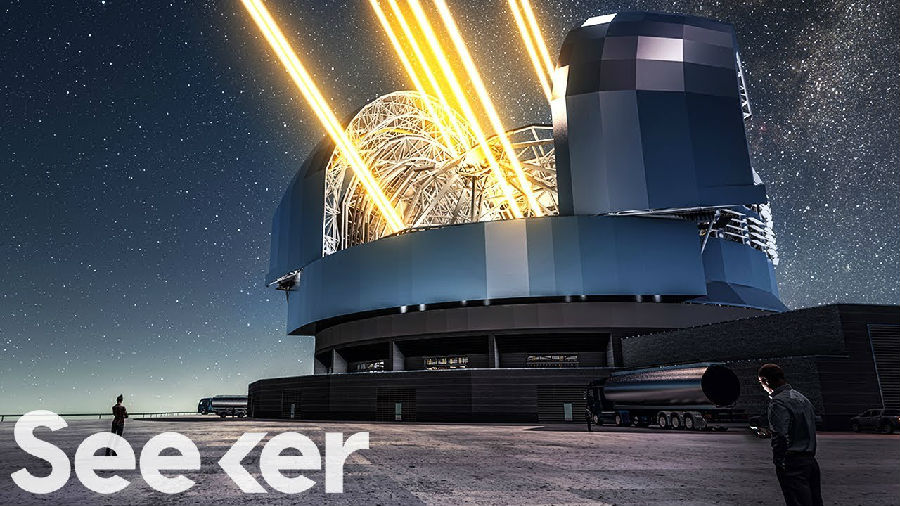(单词翻译:单击)
We’re in the middle of a billion dollar telescope building boom.
我们正处于一波建造价值10亿美元的望远镜的热潮中。
The Giant Magellan Telescope, Thirty Meter Telescope and Europe’s Extremely Large Telescope
大麦哲伦望远镜,30米望远镜和欧洲极大望远镜
are all part of a new class of ground based observatories that will peer farther through space and further back in time.
都是能观测到更遥远的时空的一类新型地面天文台的观测设施。
“Astronomers are not very good with names.
“天文学家们不太擅长命名。
First we built big telescopes, and then we made the very large telescope, and now we're making extremely large telescopes.
一开始建造的望远镜叫大望远镜,之后建造的叫甚大望远镜,现在在建的就叫极大望远镜。
But really what it means, it's about 10 times larger than any telescope we have today.”
但这个名字真正代表的意思是,它基本上是我们当今的望远镜的10倍大。
They’re all racing to see first light in the 2020s.
大家现在都在为看到20年代的第一道曙光较着劲呢。
But why now? How did we get here?
但为什么要在这个时候较劲?我们又是怎么走到今天这一步的呢?
“Typically, the size of the largest telescope on the earth doubles about every 40 years…
“通常,地球上最大的望远镜的尺寸大约每40年就会翻一番……”
Around 2000 there were groups around the globe who had just finished building telescopes of about 8 and 10 meters in diameter,
2000年左右的时候,很多地方都才刚刚完成了直径为8到10米的望远镜的建造,
and they recognized the technology could be used to make telescopes even larger.
但他们已经意识到,当时的技术其实是可以用来制造更大的望远镜的。
And that was about the time also that we discovered that as astronomers we have no idea what's actually going on in the universe.
也就是在那个时候,我们发现,作为天文学家,我们其实根本就不了解宇宙里发生的事。
I mean no idea in the sense that we figured out that 97% of the stuff in the universe can't be seen and we don't know what it is.
我的意思是,从我们发现,宇宙中97%的物质都是看不见的,我们也不知道那些物质究竟是什么这个层面来看是这样。
So that was a good motivation to build bigger telescopes.”
所以,这也是建造口径更大的望远镜的一个很好的出发点。
“The technology got better for us to make this quantum jump from, you know, eight meter to 30 meter glass...
“技术的进步让我们得以实现从8米到30米这样一个量子跃迁式的一个飞跃。
This comes down to, you know, few key elements.”
归根结底其实只有几个关键的要素。”
The first is a revolution in mirror size and design.
首先是镜子的尺寸和设计上发生了革命性的变化。
“The telescope performance are mostly driven by the size of the primary mirror.
望远镜的性能主要取决于主镜的大小。
The bigger the primary mirror, the more light we can collect….
主镜越大,能收集到的光线就越多。
That means we can go fainter into the universe, you can look at smaller objects, more distant objects.”
这也就意味着我们可以进入更深远的宇宙,看到更小,更遥远的物体。

The problem is you can't make one single mirror any large than about 20 feet in diameter.
问题是,你没有办法将镜子的尺寸做到直径20英尺(约6米)以上啊。
There's just basic material properties in the glass that make it very difficult.
造成这一困难的是玻璃里基本材质的性能。
So...we have to make mirror segments.
所以…我们只能用一小块一小块的镜子组合成一面大镜子。
We take the parent optical surface and kind of like with the biscuit cutter, we cut it into seven circles.
我们取原始的光学表面,然后用饼干切割器一样的机器把它切成七个圆。
We make them to one combined parent optical surface that brings the light then to a single focus.
把它们做成一个组合的光学表面,使光聚焦在一个焦点上。
We have to then hold those mirrors in place on a large steel structure that's stiff enough that it doesn't shake in the wind,
之后,我们必须把这些镜子固定在一个足够坚固的大型钢结构上,让它在风中也不会晃动,
and it doesn't sag under its own weight,
也不会因为自身的重量而下沉,
and then it has to be precise enough to steer across the sky so that when we move to track the stars or the planets there's no vibration.
还要精确到能绕着天空转动,确保我们追踪恒星或行星的时候不会振动。
And we do that strangely enough by floating the entire telescope, entire 1,000 tons on a thin film of oil.
非常奇怪的是,我们让整个重达1000吨的望远镜漂浮在了一层薄薄的油膜上。
The telescope simply floats on that in a way that's completely frictionless.”
望远镜竟然能零摩擦地漂浮在上面。
That’s the design for the Giant Magellan Telescope, whereas the E-ELT will take a slightly different approach.
这就是大麦哲伦望远镜的设计原理,而欧洲极大望远镜的路数又稍有不同。
“The original idea was to build, not a forty meter diameter, but 100 meter diameter.
“我们最初的想法是建造一台直径不是40米而是100米的望远镜。
And that was called the Overwhelmingly Large Telescope,
取的名字是“大到让人无所适从望远镜”,
That was so big that the engineers said "You know, this is really too much for us."
由于实在是太大了,工程师们都说:“嗯,真的太为难了。”
The shape of the telescope has to be precise to few tenths of nanometers.
望远镜的形状必须精确到十分之一纳米。
So, the width of a hair across the entire forty meter diameter of the primary, which is, actually, not even one single piece.
换句话说,一根头发的宽度就将横跨整个40米直径,还不是一整块的原始表面。
It's made of 798 individual smaller mirrors.
因为它是由798个小镜面组成的。
Each of them needs to be polished, extremely accurate, and then controlled to mimic this uniform surface at the nanometer level.”
每一个小镜面都要抛光,还要精确到极致,然后被用来模拟均匀到纳米水平的整块镜面的表面。
These enormous precision machines will be built in some of the driest and most remote places on earth,
这些巨大而精密的机器将建在地球上最干燥,最偏远的地方,
rivalling the power of space telescopes like Hubble and the soon-to-launch James Webb.
抗衡哈勃太空望远镜和即将发射的詹姆斯韦伯太空望远镜。


